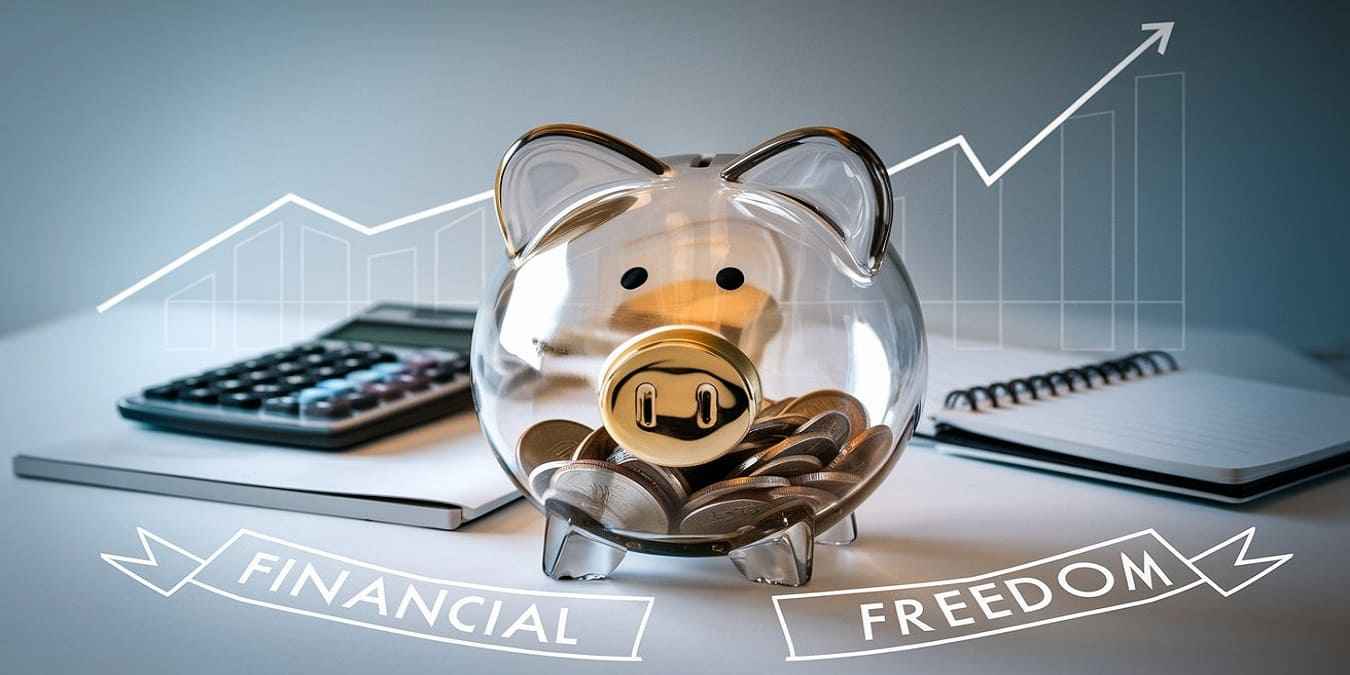
Financial Freedom 101
Imagine waking up one day and realizing you no longer have to worry about money. No more sleepless nights over bills, no more stress about unexpected expenses and no more feeling trapped in a job you don’t love.
Sounds like a dream, doesn’t it? Well, it doesn’t have to be. Financial freedom is not just a buzzword; it’s a tangible goal that you can achieve with the right mindset, strategies and discipline.
In this guide, we’ll walk you through the essential steps to take control of your finances and pave your way to financial freedom. Whether you’re just starting your journey or looking to refine your existing plan, this article is for you.
Let’s dive in.
What Is Financial Freedom?
Financial freedom means having enough savings, investments and cash on hand to afford the lifestyle you want for yourself and your family. It’s about gaining control over your money so that it works for you, not the other way around. It’s the ability to make life decisions without being overly stressed about the financial impact because you’ve planned and prepared.
As the famous quote by Robert Kiyosaki goes, “The more you learn, the more you earn.” Financial freedom is not about being rich; it’s about being in control.
Why Is Financial Freedom Important?
Think about it: How often do you feel stressed about money? Do you worry about paying bills, saving for retirement or handling emergencies? These concerns can weigh heavily on your mental and emotional well-being. Achieving financial freedom eliminates these worries, giving you peace of mind and the freedom to live life on your terms.
But how do you get there? Let’s break it down into actionable steps.
Step 1: Assess Your Current Financial Situation
The first step to taking control of your finances is understanding where you stand. You can’t plan a journey without knowing your starting point, right?
- Calculate Your Net Worth: Add up all your assets (savings, investments, property) and subtract your liabilities (debts, loans). This will give you a clear picture of your financial health.
- Track Your Spending: Where does your money go each month? Use budgeting apps or a simple spreadsheet to track your expenses.
- Identify Problem Areas: Are you overspending on dining out? Do you have high-interest debt? Pinpoint the areas where you can cut back.
Step 2: Set Clear Financial Goals
What does financial freedom look like to you? Is it retiring early, traveling the world or starting your own business? Setting clear, specific goals will keep you motivated and focused.
- Short-Term Goals: Build an emergency fund, pay off credit card debt or save for a vacation.
- Medium-Term Goals: Buy a home, start a business or save for your child’s education.
- Long-Term Goals: Achieve retirement savings, build generational wealth or become debt-free.
Remember, goals should be SMART: Specific, Measurable, Achievable, Relevant and Time-bound.
Step 3: Create a Budget That Works for You
A budget is your financial roadmap. It helps you allocate your income toward expenses, savings and investments.
- 50/30/20 Rule: Allocate 50% of your income to needs, 30% to wants and 20% to savings and debt repayment.
- Zero-Based Budgeting: Assign every dollar a job, ensuring your income minus expenses equals zero.
- Automate Savings: Set up automatic transfers to your savings or investment accounts.
The key is to find a budgeting method that fits your lifestyle and stick to it.
Step 4: Build an Emergency Fund
Life is unpredictable. Your car might break down or you might face a medical emergency. An emergency fund acts as a financial safety net, preventing you from going into debt when unexpected expenses arise.
- How Much to Save: Aim for 3-6 months’ worth of living expenses.
- Where to Keep It: Use a high-yield savings account for easy access and growth.
Step 5: Pay Off Debt
Debt can be a major obstacle to financial freedom. High-interest debt, like credit card debt, can eat into your income and limit your ability to save and invest.
- Debt Snowball Method: Pay off the smallest debts first to build momentum.
- Debt Avalanche Method: Focus on paying off high-interest debts first to save money on interest.
- Avoid New Debt: Once you pay off existing debt, avoid accumulating new debt by living within your means.
Step 6: Invest for the Future
Saving alone won’t get you to financial freedom; you need to invest. Investing allows your money to grow over time, thanks to the power of compound interest.
- Start Early: The earlier you start investing, the more time your money has to grow.
- Diversify Your Portfolio: Spread your investments across stocks, bonds, real estate and other assets to reduce risk.
- Take Advantage of Retirement Accounts: Contribute to 401(k)s, IRAs or other retirement plans, especially if your employer offers matching contributions.
As Warren Buffett wisely said, “Do not save what is left after spending, but spend what is left after saving.”
Step 7: Increase Your Income
While cutting expenses is important, increasing your income can accelerate your journey to financial freedom.
- Side Hustles: Freelancing, tutoring or selling handmade goods can bring in extra cash.
- Career Advancement: Invest in skills and education to qualify for higher-paying jobs.
- Passive Income: Explore opportunities like rental properties, dividend stocks or creating digital products.
Step 8: Protect Your Wealth
Financial freedom isn’t just about building wealth; it’s also about protecting it.
- Insurance: Ensure you have adequate health, life and property insurance.
- Estate Planning: Create a will and consider setting up trusts to protect your assets.
- Regular Reviews: Periodically review your financial plan to adjust for life changes and market conditions.
Step 9: Cultivate a Wealth Mindset
Your mindset plays a crucial role in achieving financial freedom.
- Practice Gratitude: Focus on what you have rather than what you lack.
- Avoid Lifestyle Inflation: As your income grows, resist the urge to increase your spending proportionally.
- Stay Disciplined: Consistency is key. Stick to your plan, even when it’s challenging.
Step 10: Celebrate Milestones and Stay Motivated
The journey to financial freedom is a marathon, not a sprint. Celebrate small wins along the way to stay motivated.
- Reward Yourself: Treat yourself when you reach a goal, like paying off a debt or hitting a savings target.
- Reflect on Progress: Regularly review how far you’ve come to stay inspired.
Final Thoughts
Financial freedom is within your reach if you’re willing to take control of your finances and commit to the process. It’s not about perfection but progress. Start small, stay consistent and keep your eyes on the prize.
As you embark on this journey, remember the words of Dave Ramsey: “You must gain control over your money or the lack of it will forever control you.”
By following these steps, you’ll not only take control of your finances but also create a life of abundance, security and freedom. So, what are you waiting for? Start today and take the first step toward financial freedom.
FAQs: Financial Freedom 101 – Steps to Take Control of Your Finances
- What exactly is financial freedom?
Financial freedom means having enough savings, investments and cash flow to live the life you want without being constrained by financial stress. It’s about having control over your money so that you can make choices based on your desires and goals, not out of necessity.
- How long does it take to achieve financial freedom?
The timeline varies for everyone, depending on factors like income, expenses, debt and financial goals. Some people achieve financial freedom in 5-10 years, while others may take longer. The key is to start early, stay consistent and make smart financial decisions.
- Do I need to earn a high income to achieve financial freedom?
Not necessarily. While a higher income can accelerate the process, financial freedom is more about how you manage your money than how much you earn. By budgeting, saving, investing and avoiding unnecessary debt, even those with modest incomes can achieve financial independence.
- What’s the first step to taking control of my finances?
The first step is to assess your current financial situation. Calculate your net worth, track your spending and identify areas where you can cut back. This will give you a clear starting point and help you create a realistic plan.
- How much should I save for an emergency fund?
Financial experts recommend saving 3-6 months’ worth of living expenses in an emergency fund. This ensures you’re prepared for unexpected events like job loss, medical emergencies or car repairs without derailing your financial goals.
- What’s the best way to pay off debt?
There are two popular methods:
- Debt Snowball: Pay off the smallest debts first to build momentum.
- Debt Avalanche: Focus on paying off high-interest debts first to save money on interest.
Choose the method that aligns with your personality and financial situation.
- How much should I be saving and investing?
A common rule of thumb is the 50/30/20 rule:
- 50% of your income goes to needs (rent, utilities, groceries).
- 30% goes to wants (entertainment, dining out).
- 20% goes to savings and debt repayment.
For investing, aim to contribute at least 15% of your income to retirement accounts like a 401(k) or IRA.
- What’s the difference between saving and investing?
Saving involves setting aside money for short-term goals or emergencies, typically in a savings account. Investing, on the other hand, involves putting your money into assets like stocks, bonds or real estate to grow your wealth over the long term. Both are essential for financial freedom.
- How can I increase my income?
There are several ways to boost your income:
- Side Hustles: Freelancing, tutoring or selling products online.
- Career Advancement: Upskilling, networking or negotiating a raise.
- Passive Income: Investing in rental properties, dividend stocks or creating digital products.
- What’s the best way to start investing?
Start by educating yourself about different investment options. Consider low-cost index funds or ETFs, which offer diversification and steady growth. If you’re unsure, consult a financial advisor to create a plan tailored to your goals and risk tolerance.
- How do I stay motivated on this journey?
Set clear, achievable goals and celebrate small wins along the way. Track your progress regularly and remind yourself why you’re pursuing financial freedom. Surround yourself with like-minded individuals who support your goals.
- What if I make a mistake or face setbacks?
Mistakes and setbacks are part of the process. The important thing is to learn from them and keep moving forward. Adjust your plan as needed, but don’t give up on your goal of financial freedom.
- How do I protect my wealth once I achieve financial freedom?
Protecting your wealth is just as important as building it. Ensure you have adequate insurance (health, life, property), create an estate plan and regularly review your financial strategy to adapt to life changes and market conditions.
- Can I achieve financial freedom while still enjoying life?
Absolutely! Financial freedom isn’t about depriving yourself; it’s about making intentional choices with your money. Budget for things that bring you joy, but avoid overspending on things that don’t align with your long-term goals.
- What’s the biggest mistake people make when pursuing financial freedom?
One of the biggest mistakes is not having a plan. Without clear goals and a roadmap, it’s easy to lose focus and fall into bad financial habits. Another common mistake is trying to keep up with others’ lifestyles, which can lead to unnecessary debt and stress.
- Is it ever too late to start working toward financial freedom?
It’s never too late to take control of your finances. While starting early has its advantages, even small steps taken later in life can make a significant difference. The key is to start now and stay committed.
- What role does mindset play in achieving financial freedom?
Your mindset is crucial. Cultivate a positive attitude toward money, practice gratitude and focus on progress rather than perfection. A wealth mindset helps you stay disciplined and motivated, even when challenges arise.
- How do I balance saving for the future with enjoying the present?
It’s all about balance. Allocate a portion of your income to savings and investments while also budgeting for experiences and purchases that bring you happiness. Remember, financial freedom is about creating a life you love, both now and in the future.
- What are some common myths about financial freedom?
- Myth 1: You need to be rich to achieve financial freedom.
- Myth 2: Financial freedom means never working again.
- Myth 3: It’s only about saving money, not spending it.
In reality, financial freedom is about control, balance and making choices that align with your values and goals.
- Where can I find more resources to help me on this journey?
There are countless books, podcasts and online courses about personal finance and financial freedom. Some popular recommendations include “The Total Money Makeover” by Dave Ramsey, “Rich Dad Poor Dad” by Robert Kiyosaki and podcasts like “The Ramsey Show” and “ChooseFI”















This is the fitting blog for anyone who desires to search out out about this topic. You notice so much its virtually arduous to argue with you (not that I actually would need…HaHa). You undoubtedly put a brand new spin on a topic thats been written about for years. Great stuff, simply great!